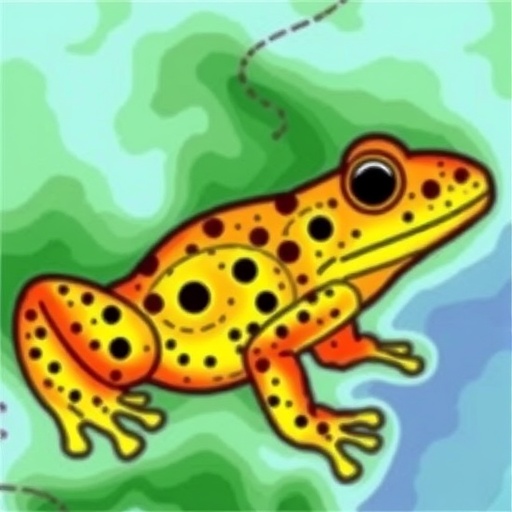
A groundbreaking study from researchers at the Smithsonian’s National Zoo and Conservation Biology Institute (NZCBI) and the Smithsonian Tropical Research Institute (STRI) offers a new beacon of hope for neotropical frogs threatened by a devastating fungal disease. Utilizing cutting-edge climate modeling and atmospheric data, the team has constructed an unprecedentedly detailed map that tracks the movement and intensity of the chytrid fungus, scientifically known as Batrachochytrium dendrobatidis (Bd), in Panama over a 13-year period. This work not only illuminates where the disease is most deadly but also pinpoints potential climatic refuges where captive-bred frogs might be safely reintroduced.
Since its scientific identification at the dawn of the 21st century, chytrid fungus has emerged as one of the most lethal threats to global amphibian biodiversity. Responsible for massive amphibian declines across continents, Bd has wiped out entire species in Panama alone, highlighting the urgency of understanding its dynamics. Thought to have originated in Asia, this pathogen thrives in cool, moist environments and spreads aggressively in such habitats. Its rapid dissemination has mystified scientists and conservationists alike, spurring a quest for innovative methods to predict and combat its impact.
Chytrid fungus, like many pathogenic fungi, displays a remarkable sensitivity to environmental conditions. Its lifecycle is intimately linked with temperature and humidity levels, flourishing in environments that remain sufficiently moist and cool but faltering under warmer, drier conditions. These climatic dependencies are key to understanding the spatial and temporal patterns of chytrid outbreaks, as well as devising strategies for intervention. Prior research has noted these environmental constraints, but until now, the granular mapping of these factors in tandem with infection data had not been realized at this scale.
.adsslot_3ohA5sFtvH{width:728px !important;height:90px !important;}
@media(max-width:1199px){ .adsslot_3ohA5sFtvH{width:468px !important;height:60px !important;}
}
@media(max-width:767px){ .adsslot_3ohA5sFtvH{width:320px !important;height:50px !important;}
}
ADVERTISEMENT
The researchers employed an innovative computational approach, integrating satellite-derived climate data with 13 years of sophisticated atmospheric modeling. This fusion of data provided ultra-high-resolution, daily maps of temperature and humidity across Panama. The clarity and precision of this climate portrait, when combined with an extensive dataset of 4,900 chytrid infection samples collected from 314 sites, allowed the team to draw correlations between environmental variables and fungal presence. Crucially, they tracked the “fungal load” — the quantity of chytrid fungal cells on frogs — over time and space, which serves as a critical measure of infection intensity.
Analysis of this comprehensive data revealed sustained Bd presence at higher elevations, where persistently cooler and wetter conditions favor fungal survival. The lowlands, by contrast, experienced cyclical seasonal boosts in Bd suitability during rainy periods, corresponding directly with waves of chytrid outbreaks. This dynamic overview underscores the complex relationship between pathogen virulence and microclimatic variation, advancing our understanding far beyond static snapshots or simple geographic occurrence maps.
Lead author Carrie Lewis, pursuing her doctoral studies in geography and geoinformation science, expressed optimism about the practical applications of these findings. By harnessing environmental data with pathogen surveillance, her team has carved a pathway toward precision conservation — where detailed climatic insights can guide the timing and location of interventions. Such refined targeting is expected to increase the success rate of conservation efforts, potentially altering the trajectory for many endangered amphibian populations.
A crucial nuance in the relationship between chytrid presence and amphibian mortality lies in the intensity of infection. Recognizing this, the research team developed three predictive models distinguishing fungal presence, medium infection intensity (indicative of serious but not necessarily lethal infections), and high infection intensity correlated with major disease outbreaks. Remarkably, these models demonstrated that weather conditions in the two weeks leading up to sampling could reliably forecast not only the presence of Bd but also the severity of infection — a major step forward in disease ecology.
The researchers’ climatic maps suggested the existence of “climatic refuges” — regions where the environmental conditions are less favorable to Bd and thus more hospitable for amphibian survival. These refuges hold outsized significance, offering potentially safe habitats for frogs suffering from chytrid infection pressures elsewhere. Identifying and protecting these areas could become a cornerstone of future conservation strategies, particularly for the re-establishment of captive-bred populations in the wild.
NZCBI biologist Brian Gratwicke emphasized that the identification of these refuges serves dual strategic purposes. First, these areas may harbor wild frogs that have developed natural resistance to chytrid, constituting invaluable genetic reservoirs for species recovery programs. Second, they represent prime candidate sites for rewilding projects, where captive-born frogs can be released with a higher likelihood of survival, helping restore ecological balance and biodiversity.
Since 2009, ongoing work by the Panama Amphibian Rescue and Conservation Project in Gamboa has resulted in successful captive breeding of 12 Panamanian frog species on the brink of extinction. The availability of this model-driven climatic insight arrives at a critical juncture, as these programs prepare for reintroduction trials. By predicting when and where chytrid poses the greatest threat, conservationists can more safely plan releases, improving the odds of sustaining wild populations for future generations.
The interdisciplinary collaboration behind this study highlights the power of merging ecology, climatology, and computational modeling. With partial funding from the National Science Foundation, the German Science Foundation, and the Bezos Earth Fund’s Tropical Amphibian Research Initiative, the research represents a significant advance in conservation science. It exemplifies how integrating diverse scientific disciplines unlocks novel solutions to urgent biodiversity crises.
The implications extend beyond Panama and amphibians. The methods developed showcase a scalable approach to understanding infectious diseases at the landscape level, one that can inspire analogous studies globally for a range of wildlife pathogens. As climate change continues to alter environmental conditions unpredictably, such predictive tools will be essential for proactive species management and disease mitigation worldwide.
Ultimately, this study stands as a testament to how data-driven, technologically sophisticated approaches can chart new avenues for protecting some of the planet’s most vulnerable creatures. By illuminating patterns previously invisible and revealing prospects for survival against overwhelming odds, it injects a much-needed sense of hope into the global fight against chytrid and amphibian extinction.
Subject of Research: Animals
Article Title: Modelling Batrachochytrium dendrobatidis Presence and Intensity Using High Spatial and Temporal Resolution Weather Data
News Publication Date: 14-Jul-2025
Web References:
10.1111/ddi.70052
Smithsonian Tropical Research Institute
Image Credits: Brian Gratwicke, Smithsonian’s National Zoo and Conservation Biology Institute
Keywords: Chytridiomycosis, Animal diseases, Climate modeling, Amphibians
Tags: amphibian biodiversity threatsBatrachochytrium dendrobatidis researchcaptive breeding for species recoveryclimate data and amphibian diseasesclimatic refuges for frogsenvironmental impact on chytrid fungusfungal pathogens and climate changeinnovative methods in wildlife conservationmapping chytrid fungus spreadneotropical frog conservation effortspredicting amphibian disease dynamicsSmithsonian conservation research





